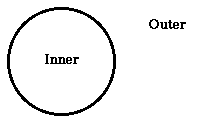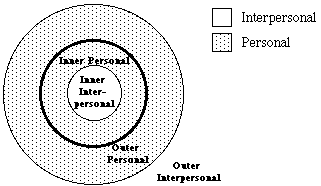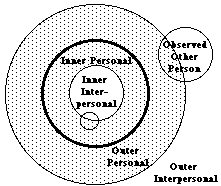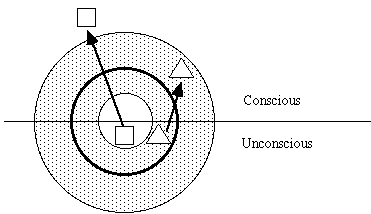
www.integralscience.org

13th Annual Meeting of
ANPA West
16 February 1997
Stanford, California
Abstract
My recent article* in the Winter 1996 issue of the ANPA West Journal introduces what I call Integral Science. Briefly, what I mean by Integral Science is a generalization of science that is comprehensive of both inner and outer domains of experience. In this talk, I will give an introduction to this idea, then explore some implications and connections with other ideas.
*McFarlane, Thomas J., "Integral Science: Toward a Comprehensive Science of Inner and Outer Experience", ANPA West, Vol. 6, No. 2 (Winter 1996).
THE TWO DOMAINS OF EXPERIENCE
We commonly regard our experience as divided into two domains: the inner domain of experience and the outer domain of experience. (There is, by the way, more than a superficial resemblance here between this diagram and those one finds in Laws of Form.)

Outer Domain
The outer domain of experience includes our experience of objects outside ourselves, such as the external world that we experience through our sensory faculties of apprehension, i.e., vision, hearing, touch, taste, and smell. Objects in the outer domain include things like chairs, other people, and so on. Generally speaking, we typically regard objects of outer experience as other than our selves, thereby distinguishing them from objects of inner experience, which are within or part of our selves.
Inner Domain
The inner domain of experience includes our experience of objects inside ourselves, such as the inner world that we experience through our inner faculties of apprehension. These inner faculties include, among other possibilities, conceptual cognition, imagination, and intuition.
THE TWO TYPES OF KNOWLEDGE
It is conventional to divide knowledge into two broad classes: public or interpersonal knowledge, and private or personal knowledge.
Interpersonal Knowledge
Knowledge that is public or interpersonal is knowledge that is shared, or agreed upon, by a community of individuals. For example, we all agree that there is a floor here beneath us. Physicists agree with each other on the charge of the electron. Mathematicians agree with each other that the Pythagorean theorem is true. Note that interpersonal knowledge is relative to a specific community of people and is associated with generally accepted methods and procedures for verifying the validity of their shared knowledge, thereby distinguishing it from private or personal knowledge.
Personal Knowledge
Private or personal knowledge is knowledge that is idiosyncratic and specific to individuals. For example, our dreams and fantasies are not usually accessible to each other. While I can know with certainty that I had a dream about an elephant stampede last night, there is no way you can verify or falsify this claim. Consequently, my dream is not considered shared knowledge.
INNER/OUTER IS NOT PRIVATE/PUBLIC
I have intentionally avoided the use of the terms subjective and objective because they are often used to mean very different things.
On the one hand, we often use subjective and objective to refer to the inner and outer domains of experience. Subjective is what's "in here", while objective is what's "out there".
On the other hand, we also use subjective and objective to refer to the personal and the interpersonal forms of knowledge. Subjective is what's private, while objective is what is public.
The point here is that the distinction between inner and outer experience is different from the distinction between private and public knowledge. Inner experience is not necessarily private. For example, mathematical knowledge is public ("objective"), and yet it is based upon inner ("subjective") conceptual experience within the minds of mathematicians. Theorems in mathematics are not verified or falsified by appeal to outer experience, but by appeal to inner experience. Thus, mathematics demonstrates that there are regions of inner experience that can form the basis for public knowledge.
Since the distinction between private and public does not coincide with the distinction between inner and outer experience, we can divide our experience into four regions as shown in the table below.
Personal or Private
Knowledge
|
Interpersonal
or Public
Knowledge
| |
| Outer
Domain of
Experience
|
Private
Sensory
Experience
|
Outer
Science
(e.g., physics)
|
| Inner
Domain of
Experience
|
Private
Conceptual and
Emotional Experience
|
Inner
Science
(e.g., math)
|
THE MAP OF EXPERIENCE
We can now augment our original map of experience to reflect the types of knowledge within the inner and outer domains:

Inner and Outer Regions of Interpersonal Experience
The impersonal region is the complement of the personal ring of experience, and it consists of an outer impersonal portion and an inner impersonal portion. The outer portion contains that part of outer experience that is considered interpersonal or shared, and it is the task of Outer Science to explore this region. The inner portion contains that part of inner experience that is impersonal or shared. Inner Sciences, such as mathematics, explore the nature of this region.
GENERALIZING THE NOTION OF SCIENCE
The existence of one science of the inner domain of experience (i.e. mathematics) opens the possibility that there are other sciences of the inner domain. This suggests that the notion of science and the scientific method may be generalized so that it is not limited to just outer science. Since such a generalization of science is integrates both Inner Science and Outer Science into one generalized Science that is comprehensive of both, I call it Integral Science.
Verification in Outer Science and in Inner Science
It is a fundamental principle of Outer Science that hypotheses be subjected to verification in the outer domain of experience by a community of trained practitioners. A physical theory, for example, is subject to the condition that its predictions must be compatible with our sensory experiences of the world of outer objects. It is important to note that only trained physicists are qualified to test physical theories against experience.
Similarly, it is also a fundamental principle of Inner Science that hypotheses be subjected to verification by a community of trained practitioners. A mathematical theorem, for example, is subject to the condition that its proof must be compatible with our inner conceptual experiences, in particular, the inner experiences of trained mathematicians.
From the above, we form a generalized principle of verification which does not depend on the domain of experience:
Propositions are subject to verification in experience (i.e., in the inner and/or outer domains of experience) by a community of trained practitioners.
THE EXPERIENTIAL BASIS FOR SCIENCE
An Integral Science of Experience, both Inner and Outer
The scientific principle of verification grounds science in experience. In the case of Outer Science, verification is grounded in our outer sensory experience. In the case of Inner Science, verification is grounded in our inner experience. Insofar as the inner and outer domains of experience are merely two aspects (and arguably arbitrary ones at that) of a coherent and integrated ground of all experience, we may simply say that Integral Science is simply the science of experience, both inner and outer. It has no bias, therefore, toward either subjective idealism or objective realism, but operates in an experiential context comprehensive of both the inner and outer domains.
Consciousness and the Ground of Experience
Insofar as the word experience implies states, time, or any structure, it is itself derivative and can be an object of study. What is common to all experience, both inner and outer, is that it is experience within consciousness. By consciousness I mean the pure spacelike field of awareness within which everything we have ever known takes place. Nothing you have ever known was known outside of consciousness. We may hypothesize the existence of things outside of consciousness, but we can only ever know them by experiences within consciousness. It follows that any scientific proposition must be a proposition about experiences within consciousness, since anything outside of consciousness is in principle unknowable and unverifiable. We thus have a second principle of Integral Science:
Scientific propositions are propositions about direct experiences within consciousness.
CONTEMPLATIVE TRADITIONS AS INNER SCIENCE
In the West we have developed a powerful and subtle Outer Science, and our Inner Science of mathematics is no less impressive. But there is good reason to suspect that this is not the whole picture. In particular, there is good reason to suspect that a complete Inner Science contains far more than just mathematics.
After stripping away all traces of dogmatism and superstition from religious traditions, one can find communities of practitioners who investigate the inner regions of interpersonal experience using highly developed methods of inner investigation, most notably, forms of meditation. Most importantly, these inner experiences are subject to verification by the community of trained practitioners.
Perhaps the purest example of such a community practicing Inner Science can be found in the Tibetan Buddhist tradition. Building on the Indian Buddhist tradition which began 2500 years ago, the Tibetan Buddhist tradition has been developing extremely sophisticated meditative practices for the investigation into the inner realms of experience for about 1000 years now. These methods of experimentation, such as meditation, are coupled with theoretical and conceptual systems which are used to guide and organize experience.
Just as we use the constraint of interpersonal verification to abstract interpersonal invariants from our outer experiences, a similar process of abstraction can be used to obtain interpersonal invariants of inner experience. Learning the subtle manner in which to properly abstract these invariants is an important part of the training of any scientist.
INNER VS. OUTER SCIENCES OF INNER PHENOMENA
The Outer Science of Inner Phenomena
Although the methods of Outer Science can be applied to outer manifestations that we may attribute to inner phenomena, Outer Science can not study inner phenomena directly. For example, the methods of outer science can be used to externally study the brain, the behavior of people, and even verbal reports of their inner states. But we can never gain access to the inner states of other people through our faculties of outer sensation. Indeed, since Outer Science is limited to the faculties of outer sensation, it can not even establish that other people even have inner states at all. This is why so many people are spinning their wheels these days in the field of consciousness studies. Trying to verify for yourself the truth of a proposition about inner states of consciousness by looking at brains and behavior in the external world is like trying to prove a mathematical theorem to yourself by studying the behavior of other mathematicians.

The Inner Science of Inner Phenomena
The best way to study inner phenomena is to study them directly from the inside, just as we study outer phenomena directly from the outside. The challenge is to develop the subtle concepts and discernment necessary to properly distinguish between the personal and impersonal components of inner experience. For example, just as in an outer experience of another person the scientist needs to carefully distinguish personal "subjective" biases projected upon them from so-called "objective" attributes, one must do the same with inner phenomena. Verification within a community of practitioners is the technique for making this distinction.
JUNG'S ARCHETYPES AND KANT'S CATEGORIES
The Archetypes of the Collective Unconscious
C. G. Jung postulated the Collective Unconscious as a region of inner interpersonal knowledge. It contains universal archetypal forms, the Archetypes of the Collective Unconscious, that play important roles in our psychological processes. Through a study of myth and dreams, he found that various expressions of the same archetypes can be found across cultures and time, playing the same roles in psychological transformations. These psychological archetypes, thus, define a subject area of Inner Science, although it is today only in its infancy.
The Forms of Intuition and Categories of Understanding
Central to Immanuel Kant's philosophy are the Forms of Intuition and the Categories of the Understanding. These are psychological structures common to all humans which are the preconditions for experience as we know it. Without the Forms of the Intuition, experience would have no spatial or temporal structure. Without the Categories of the Understanding, our thinking would be without logical structure. Although its details may require some modification in view of modern developments, Kant's philosophy of mathematics nonetheless recognized that mathematics is indeed an Inner Science of these universal structures within us.
Contemplative Maps of the Soul
Contemplative traditions have developed models of the psyche and consciousness that recognize processes and states that are of a universal nature. Elaborate models of consciousness, or maps of the soul, have been developed to guide and organize experiential exploration into inner states, many of which are only accessible by specially developed practices. (Analogously, many objects and processes in physics today are only accessible through elaborate and subtle experimental devices and procedures.)
CONNECTING OUTER AND INNER DOMAINS
The Unreasonable Effectiveness of Mathematics
It seemed remarkable to Eugene Wigner, and to many other people as well, that our mathematical structures, these "free creation of the human mind" as Einstein called them, should correspond so perfectly to the structures found in nature. It seems quite miraculous at times, and most explanations just do not seem entirely satisfying.
Kant's philosophy provides a key. There is a deep connection, if not identity, between our inner psychological structures and the structures of the outer world of experience. Although the inner and outer interpersonal regions appear disconnected, they are actually intimately related to each other. When we are looking into the outside world we are looking at a reflection of the inside world. (As we shall see in a moment, it may be that projection is the more accurate geometrical notion here.) This hypothesis makes it very reasonable that there be an effectiveness of mathematics in physical science. When we look within ourselves to mathematical structures, we are exploring the very forms that give structure to our outer experience. Similarly, the other universal structures within us, such as Jung's archetypes, correspond to the outer structures we experience in the external world as objective.
Remember, however, that these inner forms are not of a personal nature and are not subject to our personal will. We can no more change these structures of experience with our personal will than we can change the laws of mathematics by wishing them otherwise. This is a point that is perhaps not fully appreciated in certain fashionable views to the effect that we are "creators of our own reality".
PROJECTION AND THE UNCONSCIOUS
Personal Projection
Projection is a common psychological process in which personal unconscious contents are projected into conscious awareness. For example, if I have an unconscious inferiority complex, I may project stupidity onto other people and be overly critical of them as a way to consciously compensate. Thus my personal unconscious complexes are projected onto my region of personal conscious contents and effectively distorts them. By making conscious such an inner unconscious complex, I would withdraw the projection and be able to see people more truly.

Impersonal Projection
This process of personal projection suggests that a similar process of impersonal projection also takes place. In this case, structures of the impersonal or collective unconscious are projected out into the impersonal or collective consciousness. For example, Kant's Categories of the Understanding and Forms of Intuition are projected outward as objective structures of space, time, causality, and so on.
Levels of Law and Invariants of Experience
This model implies a hierarchy of experience, with deeper structures of inner experience corresponding to more and more universal or invariant forms, while more superficial structures in the personal sphere correspond to structures that are less invariant and more contingent. These structures are then projected out to give their mirror in the outer world of experience.
CONNECTIONS TO LAWS OF FORM AND LINKS
Laws of Form
Laws of Form begins with the Void, which is the most universal invariant of all. From the Void a single distinction is formed. Insofar as every world that appears depends for its existence on the distinction between an observer and an observed, this form of the first distinction is a fundamental archetypal structure at the basis of all experience. Like Kant's Forms, distinction is a form that is a necessary precondition of experience. Without it we could not have any experience at all.
In a universe built of distinctions, one builds upon the first distinction to form additional distinctions, introducing further limitations and forms and structures. Since different kinds of worlds can be built from distinctions, there is more and more room here for variation, and fewer invariant structures common to all worlds.
Links
The process of psychological projection depends on a breaking of the integrated field of experience into two parts, an unconscious part and a conscious part. The conscious fragment of any structure is the projection or reflection of its unconscious complement. It appears that the breaking of experience into these two parts to give rise to the appearance of an objective world may correspond to Etter's link theory, wherein particular forms appear in our conscious experience due to the breaking of links. The choice of where to break the link corresponds to the place where the distinction between conscious and unconscious is drawn.